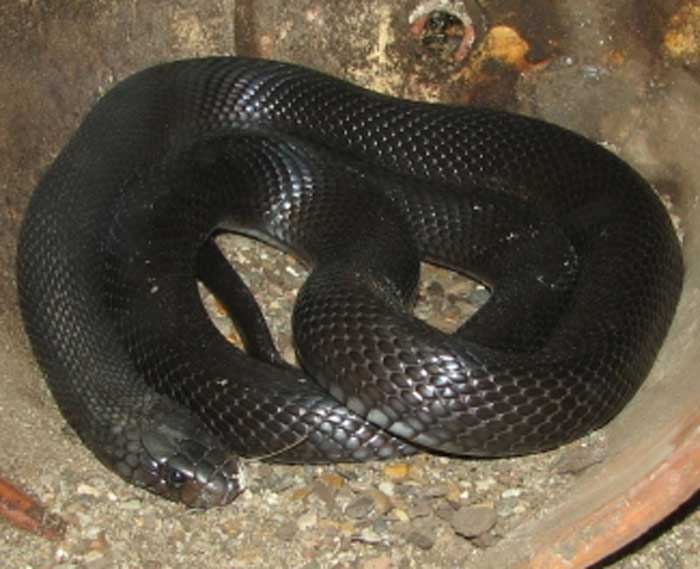
Walterinnesia aegyptia
Superregnum: Eukaryota
Regnum: Animalia
Subregnum: Eumetazoa
Cladus: Bilateria
Cladus: Nephrozoa
Superphylum: Deuterostomia
Phylum: Chordata
Cladus: Craniata
Subphylum: Vertebrata
Infraphylum: Gnathostomata
Superclassis: Tetrapoda
Cladus: Reptiliomorpha
Cladus: Amniota
Classis: Reptilia
Cladus: Eureptilia
Cladus: Romeriida
Subclassis: Diapsida
Cladus: Sauria
Infraclassis: Lepidosauromorpha
Superordo: Lepidosauria
Ordo: Squamata
Subordo: Serpentes
Infraordo: Caenophidia
Superfamilia: Elapoidea
Familia: Elapidae
Genus: Walterinnesia
Species: Walterinnesia aegyptia
Name
Walterinnesia aegyptia Lataste, 1887
Vernacular names
English: Desert Black Snake, Desert Cobra
日本語: サバククロコブラ
中文: 沙漠眼鏡蛇
Walterinnesia aegyptia, also known as the desert cobra or desert black snake, is a species of venomous snakes in the family Elapidae that is native to the Middle East. The specific epithet aegyptia (“of Egypt”) refers to part of its geographic range.[1]
Description and behaviour
(See the article on the genus at Walterinnesia)
Distribution
The range of the species encompasses southern Israel, north-western Saudi Arabia, western Jordan, Egypt’s Sinai Peninsula and possibly Lebanon. The type locality is Cairo, where the type specimen was purchased.[1]
Venom
The desert cobra is highly venomous. The subcutaneous LD50 for the venom of W. aegyptia is 0.4 mg/kg. For comparison, the Indian cobra's (Naja naja) subcutaneous LD50 is 0.80 mg/kg, while the Cape cobra's (Naja nivea) subcutaneous LD50 is 0.72 mg/kg. This makes the desert black snake a more venomous snake than both.[2] Venom toxins of the desert cobra are similar to those of the king cobra (Ophiophagus hannah), indicating a close relationship.[1]
Like many elapid snakes, the venom is primarily neurotoxic and the effects of envenenomation are due to systemic circulation of the toxins rather than from local effects on tissue near the site of injection.[3]
References
"Walterinnesia aegyptia LATASTE, 1887". Reptile Database. Peter Uetz and Jakob Hallermann. Retrieved 2 June 2021.
LD50 Menu
Longo DL, Fauci AS, Kasper DL, Hauser SL, Jameson J, Loscalzo J (editors) (2012). Harrison's Principles of Internal Medicine, 18th Edition. New York: McGraw-Hill. 4,012 pp. ISBN 978-0071748896.
Retrieved from "http://en.wikipedia.org/"
All text is available under the terms of the GNU Free Documentation License

